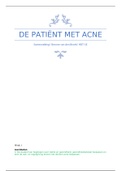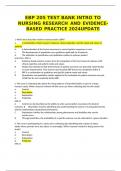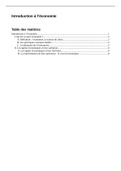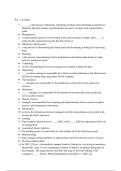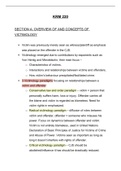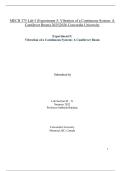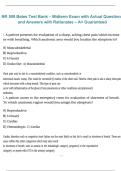Robert Kreitner & Angelo Kinicki
Chapter 1 - Organizational Behavior: The quest for People Centered
Organizations and Ethical Conduct
Organization System of consiously coordinated activities of two or more people.
Organizational behaviour Interdisciplinary field dedicated to better understanding and
managing people at work.
Seven people-centered practices that are strongly associated with much higher profits and
significantly lower employee turnover:
1. Job security (to eliminate fear of layoffs).
2. Careful hiring (emphasizing a good fit with the company culture).
3. Power to the people (via decentralization and self-managed teams).
4. Generous pay for performance.
5. Lots of training.
6. Less emphasis on status (to build a “we” feeling).
7. Trust building (through the sharing of critical information).
HISTORY OF ORGANIZATIONAL BEHAVIOR
The human relations movement was fostered by a combination of factors. First, management
began looking for new ways of handling employees. Second, behavioral scientists conducting on-
the-job research started calling for more attention to the “human” factor.
Important people: Mary Parker Follett, Elton Mayo (Hawthorn experiments) & McGregor
Theory X and Theory Y: Conducted by Douglas McGregor, important philosofical basse for the
modern view of people at work. The theories contain assumptions about people at work.
Outdated (theory X) Modern (theory Y)
Most people dislike work; they avoid it when they Work is a natural activity, like play or rest.
can.
Most people must be coerced and threatened with People are capable of self-direction and self-control if
punishment before they will work. People require they are committed to objectives.
close direction when they are working.
Most people actually prefer to be directed. They People generally become committed to
tend to avoid responsibility and exhibit little organizational objectives if they are rewarded for
ambition. They are interested only in security. doing so.
The typical employee can learn to accept and seek
responsibility.
The typical member of the general population has
imagination, ingenuity and creativity.
1
,Thanks to the concept of The Quality Movement (TQM), the quality of the goods and services we
purchase today is significantly better than in the years past. TQM can be summed up as
“continuous, customer-centered, employee-driven emprovement”. It is employee-driven because
product or service quality cannot be continuously improved without the active learning and
participation of every employee.
Four principles of TQM:
1. Do it right the first time to eliminate costly rework and product recalls.
2. Listen to and learn from customers and employees.
3. Make continuous improvement an everyday matter.
4. Build teamwork, trust and mutual respect.
The Deming Legacy: Deming called for the following, regarding the human side of quality
emprovement:
- Formal training in statistical process control techniques and teamwork.
- Helpful leadership, rather than order giving and punishment.
- Elimination of fear so employees will feel free to ask questions.
- Emphasis on continuous process improvements rather than on numerical quotas.
- Teamwork.
- Elimination of barriers to good workmanship.
One of Deming’s most enduring lessons for managers is the 85-15 rule: when things go wrong,
there is roughly an 85% chance the system is at fault (including management, machinery and
rules). Only about 15% of the time is the individual employee at fauly.
The Internet and Social Media Revolution is the development of stores moving to websites, the
organization moving to the Internet (communication). Nowadays, managers are challenged to
effectively communicate with, supervise, and lead widely dispersed individueals and teams linked
via modern telecommunications and Internet technology.
The need to build human and social capital: the need of knowledge workers, those who add
value by using their brains rather than the sweat of their backs. In the US, the following “perfect
storm” of current and emerging trends heighten the imporance and urgency of building human
capital:
- Spread of advanced technology to developing countries with rapidly growing middle classes.
- Offshoring of increasingly sophisticated jobs (e.g. product design, architecture)
- Comparatively poor math and science skills among America’s youth.
- Massive brain drain caused by retiring post-WWII baby-boom generation.
Total quality management An orginzational culture dedicated to training, continuous
improvement and customer satisfaction.
E-business Running the entire business via the Internet and managing virtual
teams.
Human capital The productive potential of one’s knowledge and actions.
Social capital The productive potential of strong, trusting, and cooperative
relationships.
2
,THE MANAGERIAL CONTEXT: GETTING THINGS DONE WITH AND THROUGH OTHERS
Management The process of working with and through others to achieve
organizational objectives, efficiently and ethically, amid constant
change.
Contingency approach Using management tools and techniques in a situationally
appropriate manner; avoiding the one-best-way mentality.
Important managerial skills (F. Shipper):
- Clarifies goals and objectives for everyone involved.
- Encourages participation, upward communication and suggestions.
- Plans and organizes for and orderly work flow.
- Has technical and administrative expertise to answer organization-related questions.
- Facilitates work through team building, training, coaching and support.
- Provides feedback honestly and constructively.
- Keeps things moving by relying on schedules, deadlines and helpful reminders.
- Controls details without being overbearing.
- Applies reasonable pressure for goal accomplishment.
- Empowers and delegates key duties to others while maintaining goal clarity and commitment.
- Recognizes good performance with rewards and positive reinforcement.
THE ETHICHS CHALLENGE
Corporate social responsibility Corporations are expected to go above and beyond following the law
(CSR) and making a profit.
Contingency approach Using management tools and techniques in a situationally
appropriate manner; avoiding the one-best-way mentality.
Carroll’s Global Corporate
Social Responsibility
Pyramid
This model traingulates
three major trends:
economic globalization,
expanding CSR
expectations and the call for
improved business ethics.
Based on the pyramid,
Carrol advises
organizations in the global
economy to:
- Make a profit consistent with expectations for international businesses.
- Obey the law of host countries as well as international law.
- Be ethical in its practices, taking host-country and global standards into consideration.
- Be a good corporate citizen especially as defined by the host country’s expectations.
3
, The Magnificant Seven: General moral principles for managers
1. Dignity of human life: The lives of people are to be respected. Humans have value and dignity.
We may not act in ways that directly intend to harm or kill an innocent person.
2. Autonomy: All persons are intrinsically valuabe and have the right to self-determination. We
should act in ways that demonstrate each person’s worth, dignity, and right to free choice.
3. Honesty: The truth should be told to those who have a right to know it. Honesty is also known
as integrity, truth telling and honor.
4. Loyalty: Promises, contracts, and commitments should be honored. Loyalty includes fidelity,
promise keeping, keeping the public trust, good citizenship, excellence in quality of work,
reliability, commitment, and honoring just laws, rules and policies.
5. Fairness: People should be treated justly.
6. Humaneness: a) Our actions ought to accomplish good. b) we should avoid doing evil.
7. The common good: Actions should be accomplish the “greatest good for the greatest number”
of people.
How managers can improve on-the-job ethics
- Behave ethically yourself
- Screen potential employees
- Develop a meaningful code of ethics; codes of ethics can have a positive impact if they satisfy
therse four criteria:
1. They are distributed to every employee
2. They are firmly supported by the top management
3. They refer to specific practices and ethical dilemmas likely to be encountered by target
employees
4. They are evenly enforced with rewards for compliance and strict penalties for noncompliance
- Provide ethics training
- Reinforce ethical behavoir
- Create positions, units and other structural mechanisms to deal with ethics
- Create a climate in which whistle-blowing becomes unnecessary
Whistle-blowing Reporting unethical/illegal acts to outside third parties.
Morally attentive Faithfully considering the ethical implications of one’s actions
RESARCHING ORGANIZATIONAL BEHAVIOUR
Meta analysis Pools the results of many studies through statistical procedure.
Field study Examination of variables in real-life settings.
Laboratory study Manipulation and measurement of variables in contrived situations.
Sample survey Questionnaire responses from a sample of people.
Case study In-depth study of a single person, group or organization
4

